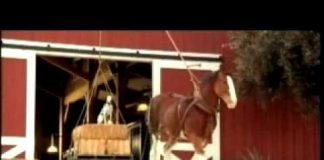
A horse that jigs and goes too fast is frustrating to deal with and no fun to ride. If you feel like you’re in a constant battle with your horse to slow down his feet, a great exercise to practice is what I call bending transitions.
Once your horse is trotting forward on a loose rein, bend him down to a walk by sitting deep in the saddle and taking your legs off to warn him that you’re about to slow down. To bend him to the left, slide one hand down the left rein and pull it up to your hip. At the same time, press the middle of your horse’s ribcage with your inside left leg to create bend in his body.
As soon as your horse transitions to a walk and softens to the bit, drop your hand down to your knee and release your leg at the same time. Your horse should keep walking the circle, bending his head and neck with slack in the rein.
If your horse tries to walk out of the circle, pull the rein back to your hip and apply pressure to his ribcage with your inside leg. When he drops his nose down toward your toe, release all the pressure. The end result will be that you can release your hand to your knee and your horse will keep the bend by himself and continue to walk forward.
After your horse walks three circles, let him out of the bend and trot him forward for a few strides before asking him to do another bending transition. Practice the exercise on both sides at the trot first. When he’s doing well at the trot and not taking off, then move on to the canter.



When you ask your horse to do the transition, even if he’s going faster than you want, be careful that you don’t panic and snatch his head around with the rein; this will just cause him to worry and go even faster. Pick up softly, and if you feel any resistance, use your inside leg to encourage him to bend and soften.
Also notice that at no point in this exercise are you to be pulling back on both reins to stop your horse. Pulling straight back on two reins will only add to his desire to go fast because it makes him feel trapped, which causes him to get nervous.
Since you’re working with a hot horse that likes to run and build speed, it’s important that initially you let him go only a few strides between each bending transition. This will help to “shorten” him mentally, meaning that it won’t take long for your horse to realize that he might as well slow down and relax because he’s not going to get very far before you shut him down. Don’t let him build his speed up to 90 miles an hour and then worry about how you’re going to stop him. Slow him down before he gets out of control.
The more you practice this exercise, the better your horse will rate off your seat and slow down.
Clinician CLINTON ANDERSON owns and operates Downunder Horsemanship in Stephenville, Texas, where his method of horsemanship has helped to transform the relationships between thousands of horses and riders. He also hosts two training programs that air weekly on Fox Sports Net and RFD-TV. www.downunderhorsemanship.com
This article originally appeared in the July 2014 issue of Horse Illustrated magazine. Click here to subscribe!






Wow, I hope I can remember all of that when my horse wants to go faster on the trails.
Great pictures, great tutorial, important advice! Definitely heading to http://www.downunderhorsemanship.com to learn some more 🙂